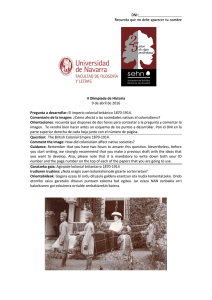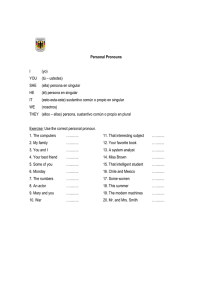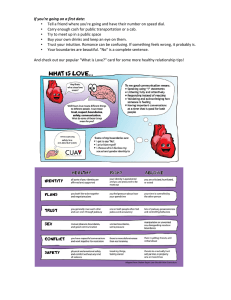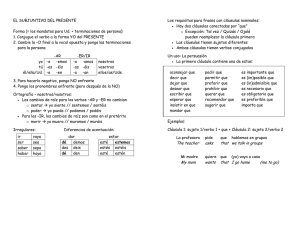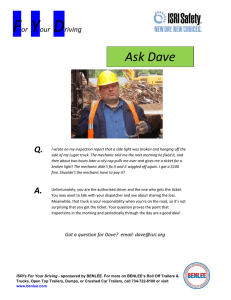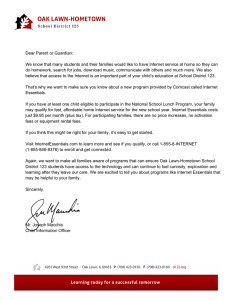Things I wish every scientist knew about science journalism
Anuncio
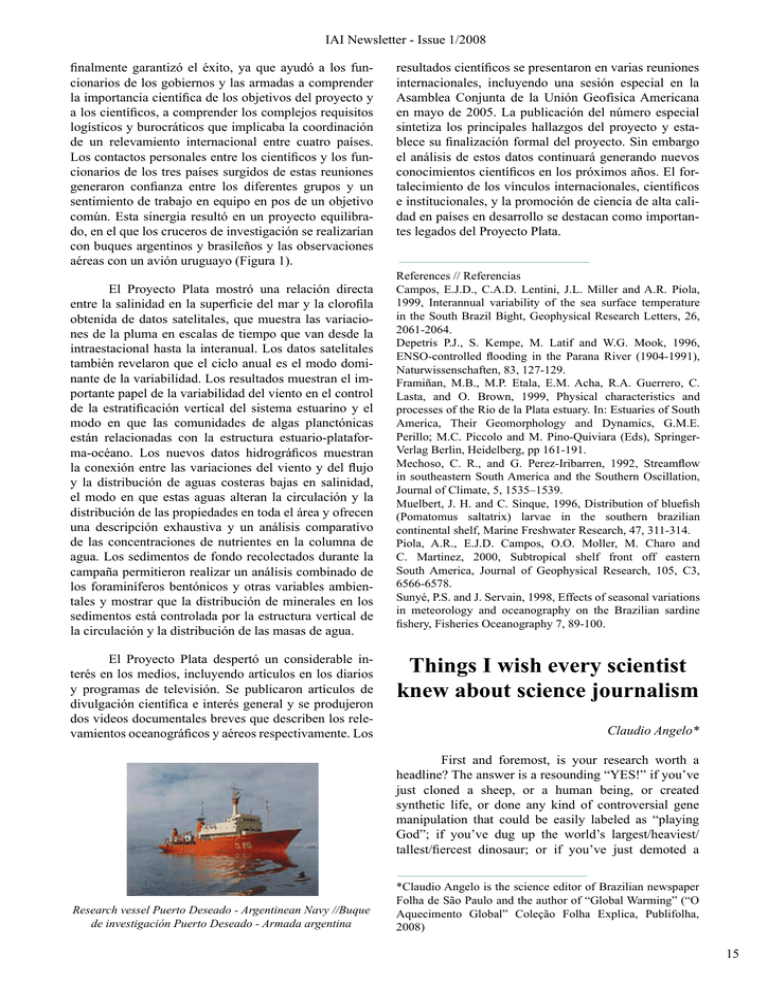
IAI Newsletter - Issue 1/2008 finalmente garantizó el éxito, ya que ayudó a los funcionarios de los gobiernos y las armadas a comprender la importancia científica de los objetivos del proyecto y a los científicos, a comprender los complejos requisitos logísticos y burocráticos que implicaba la coordinación de un relevamiento internacional entre cuatro países. Los contactos personales entre los científicos y los funcionarios de los tres países surgidos de estas reuniones generaron confianza entre los diferentes grupos y un sentimiento de trabajo en equipo en pos de un objetivo común. Esta sinergia resultó en un proyecto equilibrado, en el que los cruceros de investigación se realizarían con buques argentinos y brasileños y las observaciones aéreas con un avión uruguayo (Figura 1). El Proyecto Plata mostró una relación directa entre la salinidad en la superficie del mar y la clorofila obtenida de datos satelitales, que muestra las variaciones de la pluma en escalas de tiempo que van desde la intraestacional hasta la interanual. Los datos satelitales también revelaron que el ciclo anual es el modo dominante de la variabilidad. Los resultados muestran el importante papel de la variabilidad del viento en el control de la estratificación vertical del sistema estuarino y el modo en que las comunidades de algas planctónicas están relacionadas con la estructura estuario-plataforma-océano. Los nuevos datos hidrográficos muestran la conexión entre las variaciones del viento y del flujo y la distribución de aguas costeras bajas en salinidad, el modo en que estas aguas alteran la circulación y la distribución de las propiedades en toda el área y ofrecen una descripción exhaustiva y un análisis comparativo de las concentraciones de nutrientes en la columna de agua. Los sedimentos de fondo recolectados durante la campaña permitieron realizar un análisis combinado de los foraminíferos bentónicos y otras variables ambientales y mostrar que la distribución de minerales en los sedimentos está controlada por la estructura vertical de la circulación y la distribución de las masas de agua. El Proyecto Plata despertó un considerable interés en los medios, incluyendo artículos en los diarios y programas de televisión. Se publicaron artículos de divulgación científica e interés general y se produjeron dos videos documentales breves que describen los relevamientos oceanográficos y aéreos respectivamente. Los resultados científicos se presentaron en varias reuniones internacionales, incluyendo una sesión especial en la Asamblea Conjunta de la Unión Geofísica Americana en mayo de 2005. La publicación del número especial sintetiza los principales hallazgos del proyecto y establece su finalización formal del proyecto. Sin embargo el análisis de estos datos continuará generando nuevos conocimientos científicos en los próximos años. El fortalecimiento de los vínculos internacionales, científicos e institucionales, y la promoción de ciencia de alta calidad en países en desarrollo se destacan como importantes legados del Proyecto Plata. References // Referencias Campos, E.J.D., C.A.D. Lentini, J.L. Miller and A.R. Piola, 1999, Interannual variability of the sea surface temperature in the South Brazil Bight, Geophysical Research Letters, 26, 2061-2064. Depetris P.J., S. Kempe, M. Latif and W.G. Mook, 1996, ENSO-controlled flooding in the Parana River (1904-1991), Naturwissenschaften, 83, 127-129. Framiñan, M.B., M.P. Etala, E.M. Acha, R.A. Guerrero, C. Lasta, and O. Brown, 1999, Physical characteristics and processes of the Rio de la Plata estuary. In: Estuaries of South America, Their Geomorphology and Dynamics, G.M.E. Perillo; M.C. Piccolo and M. Pino-Quiviara (Eds), SpringerVerlag Berlin, Heidelberg, pp 161-191. Mechoso, C. R., and G. Perez-Iribarren, 1992, Streamflow in southeastern South America and the Southern Oscillation, Journal of Climate, 5, 1535–1539. Muelbert, J. H. and C. Sinque, 1996, Distribution of bluefish (Pomatomus saltatrix) larvae in the southern brazilian continental shelf, Marine Freshwater Research, 47, 311-314. Piola, A.R., E.J.D. Campos, O.O. Moller, M. Charo and C. Martinez, 2000, Subtropical shelf front off eastern South America, Journal of Geophysical Research, 105, C3, 6566-6578. Sunyé, P.S. and J. Servain, 1998, Effects of seasonal variations in meteorology and oceanography on the Brazilian sardine fishery, Fisheries Oceanography 7, 89-100. Things I wish every scientist knew about science journalism Claudio Angelo* First and foremost, is your research worth a headline? The answer is a resounding “YES!” if you’ve just cloned a sheep, or a human being, or created synthetic life, or done any kind of controversial gene manipulation that could be easily labeled as “playing God”; if you’ve dug up the world’s largest/heaviest/ tallest/fiercest dinosaur; or if you’ve just demoted a Research vessel Puerto Deseado - Argentinean Navy //Buque de investigación Puerto Deseado - Armada argentina *Claudio Angelo is the science editor of Brazilian newspaper Folha de São Paulo and the author of “Global Warming” (“O Aquecimento Global” Coleção Folha Explica, Publifolha, 2008) 15 IAI Newsletter - Issue 1/2008 planet from its planetary status. This is the obvious kind of newsworthy stuff, but they don’t happen every day. In a sense, those stories don’t represent the scientific process properly: science is all about increment, about laying the bricks on the wall one by one. It parts fundamentally with the timing of journalism, which needs a breakthrough every day. So how should you evaluate the relevance of any given scientific paper? From a newsmaker’s standpoint, in order to qualify as news your research should be novel (it’s amazing how press officers usually think that research that is only replicating stuff done abroad is novel), should be published in a fine, peerreviewed, high-impact journal and, which is paramount, should either answer or attempt to answer an important question. Now, you may argue we’re stepping onto slippery ground here. After all, who am I to decide what an “important” question is? Of course your research is important, otherwise you wouldn’t be working on it – right? Well, yes and no. If you’re a climate scientist who’s been devoting your career to constrain one given parameter to a climate model, and you succeed at, say, lowering the error bar from 90% to 10%, that might be a big improvement for that particular model. You may even get a paper in Nature magazine, or a Nobel Prize. But that wouldn’t necessarily be important to people on the street, or worth explaining to your brother-inlaw. But oddly enough, sometimes research that doesn’t come up with big answers can make big news. Consider one of the best projects in Brazilian science to date, the Large Experiment on the Biosphere-Atmosphere in the Amazon (LBA). In the end, it has hardly answered any fundamental question about how the Amazon ecosystem really works. One could even argue that LBA has only produced more questions. LBA was a media hit because it was too big to be ignored: “Large” was right in the title! Besides, it was well-funded; it managed to bring together hundreds of scientists, the best minds in the field both in Brazil and abroad. It convened open scientific meetings to discuss the progress made; and it actually produced tons of papers in peer-reviewed, high-impact journals. LBA was also exciting from the scientific perspective and had a potential for capturing the public’s imagination because of the question it tackled: how does a tropical forest work? The relationship between the inner workings of an ecosystem that’s right in our backyard and global change made a perfect link between the local angle and the global story. That’s why we could read about LBA both in Folha de São Paulo and in Scientific American. If your research project can make this kind of connection, it will be taken up by the news media. If the news media ever know about it, that is. Apart from its annual meetings, LBA scored poorly on pitching to the media. Finding out about LBA projects and forthcoming 16 “hot” papers in their website was all but impossible, and on many an occasion I would only learn about them through the press releases of Nature and Science. I imagine that contacting the media is a big deal for scientists. Many despise reporters; many dread them. It doesn’t need to be so. I hope to convince you that much of the prejudice against journalists is driven by myths and misconceptions. First of all, the myth that reporters only want a sensational story and won’t bother to read your paper. In fact, Brazil (and other countries, such as Argentina, Chile, Colombia and Mexico) has a fine body of well-prepared science writers, who will read your paper – as long as you make it available to them. Some journals have strict embargo policies. Science writers know that and have no problems with this fact. Para que la comunicación sea efectiva, las partes deben aclarar sus puntos de vista, escalas temporales y lenguajes There’s also the myth that journalists “just don’t get it”. Have you tried explaining to them? It takes patience, and it takes good will. You need to be available to take questions whenever the reporter needs to, however late in the evening or early in the morning. So please make yourself available: it will increase mutual trust and prevent mistakes in the copy. In time, try and negotiate exclusivity with reporters whose work you like and/or trust. Nothing will make a reporter happier than a scoop. And they take it seriously. Sometimes it’s better to have the main headline on a single newspaper than a bunch of short notes. You also have to understand that journalists are not at your service. They are not press officers who will feel obliged to fully state ALL of your institutional information and list all of your sponsors. They are not your friends and they will not necessarily tell their story from the angle that suits you best. Indeed, good science writers will rush straight to your academic rivals and show them your paper and put their comments in the copy. If you want a rosy, unilateral tale, have a press release, not a news story. Last, a word on press officers. It’s too bad that Latin America doesn’t have a press service such as EurekAlert! (www.eurekalert.org), where registered reporters can have access to press releases with the best research produced in American institutions. Unfortunately, the lack of such service puts some of the burden of outreach on the shoulders of scientists. That can be eased by having a good relationship with your IAI Newsletter - Issue 1/2008 own press officers. MIT astronomer Richard Binzel has a white board in his office in which he lists his publications by status: “just-published”, “submitted”, “in press”, “drafted”. If you could provide your press officer with such a list, he or she would have a much easier time reaching out to reporters. And journalists, in turn, would have a much easier time tracking down your research. Cosas que desearía que los investigadores supieran sobre el periodismo científico Claudio Angelo* Primero y principal, ¿tu investigación vale un titular? La respuesta es un rotundo “¡SÍ!”, siempre y cuando hayas clonado una oveja o una persona, creado vida sintética, o cualquier clase de manipulación genética controvertida que pudiera ser fácilmente caratulada como “jugar a ser Dios”; o quizá si has hallado el dinosaurio más grande, más pesado, más alto o más feroz del mundo; o si acabas de destituir un planeta de su condición de tal. Esta clase de cosas tiene un obvio interés periodístico, pero no suceden todos los días. De alguna forma, esas historias no representan adecuadamente el proceso científico: la ciencia se conforma de etapas, colocando uno a uno los ladrillos en la pared. Esto dista radicalmente de los tiempos periodísticos, que a diario requieren de grandes avances. Entonces, ¿cómo deberías evaluar la relevancia de un trabajo científico? Desde el punto de vista de los reporteros, tu investigación debe ser novedosa para ser considerada noticia (es increíble que en muchas oficinas de prensa se piense que replicar investigaciones realizadas en el extranjero sea algo novedoso), debería publicarse en una buena revista arbitrada y de alto impacto, y lo que es principal, debería responder o tratar de responder una pregunta importante. Podrías decir que estamos entrando en terreno pantanoso. Después de todo, ¿quién soy yo para decidir qué pregunta es “importante”? Por supuesto, tu investigación es importante, ya que de otro modo, no la estarías haciendo, ¿verdad? Bien, sí y no. Si eres un investigador del clima que dedica su carrera a restringir un parámetro dado en un modelo climático y logras, digamos, reducir el error de 90% a 10%, habrás hecho un gran avance *Claudio Angelo es editor científico del periódico brasileño Folha de São Paulo y autor de “Calentamiento Global” (“O Aquecimento Global” Coleção Folha Explica, Publifolha, 2008) para ese modelo en particular. Pueden incluso publicar tu trabajo en la revista Nature o darte el Premio Nóbel, pero eso no necesariamente haría que tu trabajo fuera importante para el ciudadano común, o que valiera la pena explicárselo a tu cuñado. Pero a veces, aunque parezca mentira, trabajos de investigación que no brindan grandes respuestas pueden constituir grandes noticias. Consideremos uno de los mejores proyectos científicos brasileños hasta la fecha, el Experimento de Gran Escala de la Biósfera y la Atmósfera en la Amazonia (LBA). A fin de cuentas, apenas si ha respondido alguna pregunta fundamental sobre cómo funciona el ecosistema amazónico en realidad. Podría incluso decirse que LBA sólo generó más interrogantes. LBA fue un hit en los medios porque era demasiado grande para ser ignorado. ¡Grande estuvo bien puesto en el título! Además, es un programa bien fundado; logró reunir a cientos de científicos, los mejores cerebros de Brasil y el extranjero. Organizó reuniones científicas abiertas para discutir sus avances y produjo toneladas de trabajos científicos en revistas arbitradas de alto impacto. LBA también fue apasionante desde el punto de vista científico y tuvo el potencial de captar la imaginación del público por el interrogante que abordaba: ¿cómo funciona una selva tropical? La relación entre el funcionamiento interno de un ecosistema que está justo a la vuelta de la esquina y el cambio global estableció el vínculo perfecto entre el punto de vista local y la historia global. Por eso pudimos leer sobre LBA tanto en Folha de São Paulo como en Scientific American. Si tu proyecto de investigación puede realizar este tipo de conexiones, los medios informativos lo tomarán en cuenta. Esto es, siempre y cuando logren enterarse de su existencia. Aparte de sus reuniones anuales, LBA tuvo un desempeño pobre en dirigirse a los medios. Averiguar sobre LBA o sus trabajos científicos “candentes” de próxima aparición en el sitio web del proyecto fue completamente imposible, y en muchos casos, sólo me enteré de ellos a través de los comunicados de prensa publicados en Nature y Science. Imagino que para los científicos no debe ser nada fácil ponerse en contacto con los medios. Muchos desprecian a los periodistas; otros les tienen pavor. No es necesario que sea así. Espero convencerlos de que gran parte del prejuicio contra los periodistas se basa en mitos e ideas equivocadas. En primer lugar, está el mito de que los periodistas sólo buscan historias sensacionalistas y que no se molestarán en leer sus trabajos científicos. De hecho, Brasil (y otros países como Argentina, Chile, Colombia y México) tiene un magnífico grupo de escritores científicos con buena formación, que leerán sus trabajos, en la medida en que puedan tener acceso a ellos. Algunas revistas tienen políticas estrictas respecto de los tiempos a partir de los cuales una noticia puede divulgarse. Los escritores científicos lo saben y viven con ello. 17 IAI Newsletter - Issue 1/2008 Existe también el mito de que los periodistas “no entienden nada”. ¿Han tratado de explicarles? Requiere paciencia y buena voluntad. Debes estar disponible para responder a sus preguntas, aunque sea tarde por la noche o temprano a la mañana. Así que por favor, está disponible: esto aumentará la confianza mutua y evitará errores. Con el tiempo, trata de negociar la exclusividad con algún periodista cuyo trabajo te guste y/o en quien confíes. Nada hará más feliz a un periodista que una primicia y la tomará en serio. A veces es mejor tener el titular principal en un solo periódico que un puñado de notas breves. Scientists do not need to wait until they discover something astonishing to reach out to science journalists Tienes que entender también que los periodistas no están a tu servicio. No son oficinas de prensa institucionales que se sienten obligadas a publicar TODA la información institucional que proveas ni enumerar a todos tus patrocinadores. No son tus amigos y no necesariamente relatarán la historia desde el mejor ángulo para ti. De hecho, un buen escritor científico irá directamente hacia tus rivales académicos, les mostrará tus trabajos y tomará nota de sus comentarios. Si deseas una historia halagüeña y unilateral, haz un comunicado de prensa, no una nota periodística. Finalmente, unas palabras acerca de las oficinas de prensa institucionales. Es muy malo que América Latina no cuente con un servicio de prensa como EurekAlert! (www.eurekalert.org), donde los periodistas registrados tienen acceso a comunicados de prensa sobre los mejores trabajos de investigación llevados a cabo en instituciones estadounidenses. Lamentablemente, la falta de un servicio como ese, pone parte del peso de la difusión en los hombros de los científicos, lo que puede aliviarse manteniendo una buena relación con sus propias oficinas de prensa. El astrónomo de MIT, Richard Binzel, tiene una pizarra blanca en su oficina donde enumera sus publicaciones por estado: “recién publicado”, “enviado”, “en prensa”, “en preparación”. Si tu oficina de prensa contara con una lista de este tipo, podría comunicarse más rápida y fácilmente con los periodistas, y ellos por su parte, tendrían menos dificultad para localizar tus trabajos. Dissemination of controversial issues: the case of global warming Diana Cazaux* I recently gave a talk entitled “Global warming: new approaches for scientific journalism”, at the 5th Ibero-American conference for scientific journalism in Quito, Ecuador. While trying to define the title of my presentation, I decided to check the dictionary for definitions of weather and climate. I learned that global warming was first used to describe the temperature rise of the planet’s surface. Climate change, on the other hand, was used to describe a temperature rise and all its derived effects, such as storms, floods, droughts and heat waves. The evolution of research led to the definition of a new concept, global change, which expanded the meaning of climate change to include the human dimensions and socioeconomic implications. When considering the environmental education function that the media has, and complex issues such as climate and global change, training and specialization of journalists appears increasingly necessary, particularly since almost all environmental knowledge is provided to society by the media. A journalist has to be specialized in order to be able to write about controversial environmental issues. A journalist trained in environmental sciences will be able to identify reliable sources and will question the pronouncements of the press officers, politicians’ spokespersons or the biased discourse of environmental experts. A science journalist will differentiate scientific papers which only appear scientifically sound from those that are in fact academically reliable. Flint and Dent corn // Maíz Flint y Dent Cortesía MAIZAR y sus miembros 18
